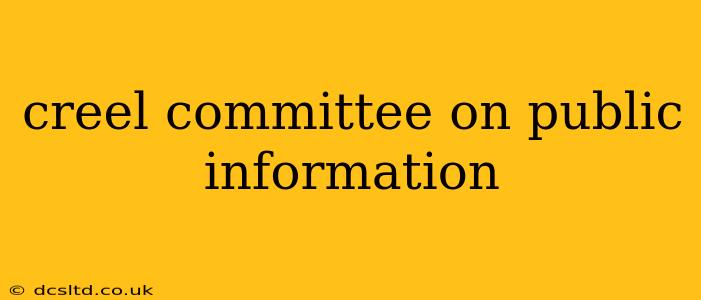The Committee on Public Information (CPI), more commonly known as the Creel Committee, was a United States government agency established on April 13, 1917, during World War I. Headed by journalist George Creel, its primary mission was to influence public opinion in support of the war effort. This involved a massive propaganda campaign that utilized a variety of methods, shaping not only American attitudes towards the war but also leaving a lasting legacy on the relationship between government and the media. This exploration delves into the committee's operations, impact, and lasting relevance.
What was the purpose of the Creel Committee?
The Creel Committee's primary purpose was to galvanize American support for World War I. President Woodrow Wilson, understanding the necessity of a unified national effort, tasked the committee with generating enthusiasm for the war, combating anti-war sentiment, and promoting the sale of war bonds. This involved fostering patriotism, demonizing the enemy (Germany), and presenting a clear and consistent narrative about the war's objectives. The committee's multifaceted approach included public speaking tours, the distribution of pamphlets and posters, and the engagement of influential figures in the media.
What methods did the Creel Committee use to achieve its goals?
The Creel Committee employed a comprehensive strategy to shape public opinion. This included:
-
Propaganda Distribution: The CPI produced and distributed millions of pamphlets, posters, and other printed materials promoting patriotism and support for the war. These materials often depicted heroic American soldiers, villainized the enemy, and emphasized the righteousness of the American cause.
-
Public Speaking and Events: The committee organized public speaking tours featuring prominent figures, including actors and athletes, who delivered speeches supporting the war effort to audiences across the country.
-
Film and Media Engagement: The CPI worked closely with Hollywood studios and the media to produce films and newsreels that supported the war effort. These films often showcased American heroism and the brutality of the enemy. They also subtly influenced public opinion through carefully crafted narratives and imagery.
-
News Management and Censorship: While the CPI didn't directly censor the press, it actively worked to shape the narrative presented in newspapers and magazines through press releases and strategic information dissemination. This included downplaying negative news about the war and highlighting American successes.
How effective was the Creel Committee?
The Creel Committee was remarkably successful in achieving its primary goals. It effectively mobilized public opinion behind the war effort, raising funds for the war through bond sales and generating widespread support for the draft. Its propaganda campaign created a sense of national unity and purpose during a time of great uncertainty and division. The committee's impact on the American psyche was profound, leaving a lasting legacy on the way government agencies interact with the media and public opinion.
What is the legacy of the Creel Committee?
The Creel Committee’s legacy is complex. While it successfully rallied public support for the war, it also demonstrated the power of government propaganda to shape public opinion and potentially manipulate the public. This raises concerns about the ethical implications of government involvement in shaping public discourse, a debate that continues to this day. The committee's methods provided a blueprint for future government propaganda campaigns, both domestically and internationally. Understanding its techniques offers valuable insight into the history of public relations, media manipulation, and the ongoing relationship between government and the press.
What were some criticisms of the Creel Committee?
While highly effective, the Creel Committee was not without its critics. Some argued that its propaganda was overly manipulative and deceptive, fostering an atmosphere of fear and intolerance. Others criticized the committee's suppression of dissenting viewpoints, which contributed to a climate of conformity and stifled free speech. These criticisms highlight the inherent tension between the need for national unity during wartime and the preservation of democratic freedoms. The legacy of the Creel Committee serves as a potent reminder of the need for vigilance in maintaining a free and open exchange of ideas, even during times of national crisis.
This exploration of the Creel Committee offers a comprehensive overview of its role, methods, impact, and lasting relevance in shaping public opinion during a critical moment in American history. The committee's legacy remains a subject of ongoing study and debate, highlighting the enduring power of propaganda and the importance of critical media literacy.
